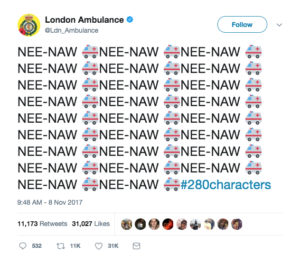As Shakespeare once said, “Brevity is the soul of wit.” Apparently, Twitter executives disagree.
When the platform went live in early 2006, Twitter made its niche in an ocean of social media by allowing users to share SMS-style updates on their day-to-day activities in a single 140 character Tweet.
 In the decade since, the company’s popularity has exploded, becoming the ninth largest social network with an active user-base of 330 million. At every step along the way, the platform has adapted to the needs of its users — first was a function to mention users, followed by the inauguration of the hastag, which has since disemminated through platforms such as Facebook.
In the decade since, the company’s popularity has exploded, becoming the ninth largest social network with an active user-base of 330 million. At every step along the way, the platform has adapted to the needs of its users — first was a function to mention users, followed by the inauguration of the hastag, which has since disemminated through platforms such as Facebook.
Twitter’s most recent change, however, hasn’t had such a warm reception. What was once Twitter’s greatest asset and users’ greatest challenge changed when the 140 character limit was doubled.
After a trial period initialized in September whereby randomized users were granted the character extension, the update migrated to the mainstream of Twitter as of Tuesday, Nov. 7, 2017.
While some prominent groups have been enjoying the increased capabilities of 280 character tweets, it was clear that not all users were pleased with the update. Since the change, Twitter users small and large, have joined the conversation to express their opinion — now to a greater extent than ever.
Beyond joke postings of popular movie monologues and song lyrics, there have been those such as writers Stephen King, J.K. Rowling, Neil Gaiman, and Lin Manuel Miranda, who criticized the update for “destroying” the unique selling point of the platform. With extra characters, they argued, Twitter’s original intent for inventiveness was made moot.
Others have more basic concerns, like CNN’s David McKenzie, who complained that the extension made users feel compelled to use all 280 characters.
“A lot of essays floating around today,” he complained in a (brief) Tweet of his own.
Following concerns from the U.S. federal government surrounding Russian election propoganda and the Nov. 3 deletion of President Donald Trump’s Twitter account by a rogue employee, it has been speculated that the character extension was not so much in the interest of users, as it was of the company itself.
According to Twitter, the move came in an effort to make it “easier” to Tweet. In an official Twitter blog post, Aliza Rosen — a project manager at Twitter — noted this motive, stating that, “historically, nine per cent of Tweets in English hit the character limit. This reflects the challenge of fitting a thought into a Tweet, often resulting in lots of time spent editing and even abandoning Tweets.”
However, many Twitter users have expressed other desires for the platform which have yet gone unmet, including the capacity to edit Tweets once they have been sent.
In a final move, Twitter announced on Thursday Nov. 9 that user names too will be expanded to allow for a 50 character limit.
How the change will affect the growth of the platform remains to be seen.






























